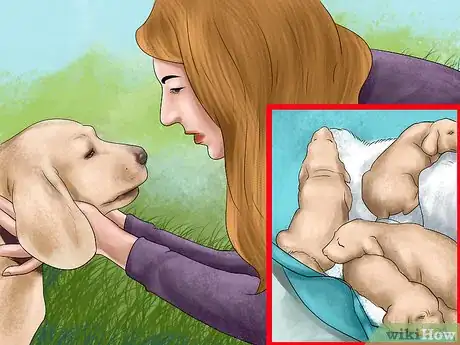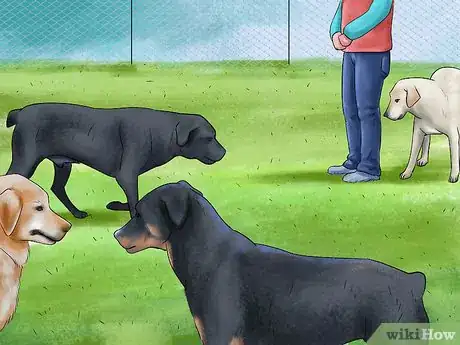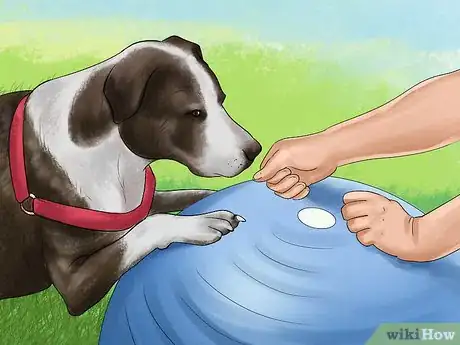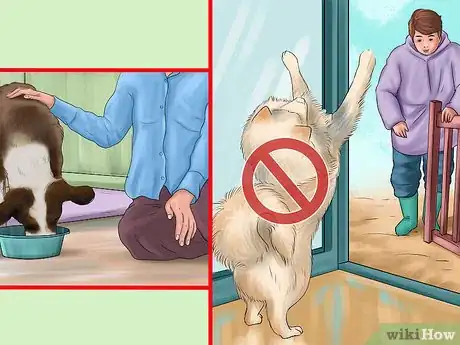This article was co-authored by Dee Hoult. Dee Hoult is the CEO of Applause Your Paws, Inc., South Florida's largest privately-owned dog training company. With over 15 years of experience, Dee specializes in correcting dog behavior problems by providing engaging, positive education and non-intimidating training. Dee holds a BS in Marine Science and Biology and an MBA from the University of Miami. She is a credentialed Certified Professional Dog Trainer through the Certification Council for Professional Dog Trainers and a credentialed Certified Dog Behavior Consultant (CDBC) through the International Association of Applied Behavior Consultants (IAABC). In 2018, Dee was a finalist for Woman of the Year for the Women in the Pet Industry Awards.
This article has been viewed 26,981 times.
Dogs can make wonderful and compassionate pets, especially when they are well behaved. While some dog owners prefer a high-energy, high-maintenance breed—or even an aggressive dog to serve as a hunter or guard—others enjoy a more docile and gentle dog. If you want a gentle dog to serve as a pleasant companion, you'll need to look into an appropriate breed before adopting or purchasing a dog. You should also train your dog to not roughhouse or bite. If you'd rather not do this training yourself, you can pay a professional trainer to teach your dog. Always give your dog plenty of affectionate and positive reinforcement when it behaves well.
Steps
Selecting a Gentle Dog
-
1Research dogs that have gentle dispositions. Although any breed of dog can have a kind disposition and be inclined towards gentleness, different breeds have different behavioral dispositions due to breeding and genetic traits. Research breeds online or by talking with informed individuals at pet stores or veterinary clinics in your area. Dog breeds that have gentle dispositions include: Great Danes, Beagles, Newfoundlands, and Pugs.
- Consider what you want in a dog: would you prefer a lazy, mellow pet, or a dog that is athletic and high-energy?
- If you're set on getting a purebred animal, look into the breed's history. If you're looking for a gentle pet, avoid dogs that have been bred for violent activities such as guarding or animal hunting.
-
2Select a friendly breed. To ensure that you find a gentle and pleasant dog, opt for a dog whose breed is considered friendly and easy-going. Breeds known to be high-strung, or which require excessive training or high maintenance, may not develop into the gentle dog you're looking for. A few outgoing, fun-loving breeds are: Irish Setters, Beagles, Boxers, and Welsh Corgis.
- Breeds that are commonly considered affectionate include: golden retrievers, Labrador retrievers, Irish wolfhounds, Collies, English bulldogs, and Great Danes.[1]
Advertisement -
3Look for an affectionate dog. Aside from breed characteristics, you want to do everything possible to ensure that your specific dog is an affectionate, gentle, and pleasant pet.[2] If possible, spend some time with a potential pet before you bring it home. This is especially important if you're adopting a grown animal from a pet shelter, since adult dogs will be less likely to change their behavior in a new home.
- Make sure you're getting your dog from a reputable breeder or rescue that properly socialized it. Dogs that aren't socialized are more likely to have behavioral problems.[3]
- If you're bringing home a puppy, you should still try to spend time with it before the adoption to make sure that it's gentle.
- If you have your choice of a number of puppies (an entire litter, for example), spend time with the puppies and choose one that seems outgoing and personable.[4]
Bringing up an Obedient Dog
-
1Train your dog using positive reinforcement. Rather than punishing your dog for mistakes they have made, which will teach your dog to fear you, positively reinforce their good behaviors. When your dog obeys a command or completes a task correctly, praise your dog and give them a treat or piece of food.
- Taking your dog to an obedience training course is a great way to have your dog trained quickly and effectively. Make sure that the training instructors themselves use positive reinforcement, and other gentle training methods.
-
2Socialize your dog early and often. To ensure that your dog will along well with other dogs and other humans (the dogs' owners) and will have a pleasant disposition, avoid secluding your dog.[5] After about a month of learning your dog's behavior, let it interact with other animals and humans frequently in safe spaces where your dog won't feel threatened or uncomfortable.[6] These interactions will help your dog develop social relationships and healthy interactions with humans and other dogs.
- One way to socialize a new dog—especially a puppy—is to have a “puppy party.” Invite various friends, especially people who are calm and enjoy being around dogs.[7]
- You can also invite other dog-owners to bring their dogs over to meet yours, or agree to meet at a dog park to let the dogs run together. Your dog should be enjoying itself during these interactions — if it seems stressed, it may actually become more anxious. Don't invite so many dogs over that your dog gets overwhelmed.[8]
-
3Teach your dog how to walk on a leash. Dogs can be remarkably unpleasant when they walk improperly on a leash and refuse to walk with their owner, or drag their owner along behind them. Make the walk walk by your side, and don't let it pull on the leash.
- When you're walking your dog and you pass another dog, stop and let the two interact for about 3 seconds before moving on. This can help it get more comfortable around others.[9]
- If your dog gets excited or aggressive when another dog is near, continue your walk. If you give in and let your dog approach the strange dog, your dog will think this behavior is acceptable.
Discouraging Negative Behavior
-
1Prevent your dog from play-biting. Although roughhousing and play-biting can seem cute and affectionate when your dog is a puppy, as the dog matures, this behavior becomes unpleasant and can even be painful. Prevent your dog from biting by pulling back or yelling “Ouch!” when it play-bites. Move away from your puppy for a couple of minutes. When you return, resume gently playing.[10]
- This behavior mimics the way that puppies learn to tussle and play with one another in their litters.
- Preventing your dog from biting will let it know how to behave gently.
-
2Don't tease your dog when playing games. If you play a game—fetch, for example—and repeatedly tease your dog, you run the risk of teaching it that playtime is unpleasant and should be avoided. This can diminish the bond between dog and owner, and will result in a less gentle adult dog.
- Avoid playing other rough games with your dog. Even a game like tug-of-war can teach your dog that it's OK to take things away from humans, and that ripping objects out of your grasp is appropriate.
-
3Don't punish your dog after it has misbehaved. After-the-fact punishment has been shown to work ineffectively. For example, it's not helpful to yell at your dog after it has broken a household object or gone to the bathroom inside, unless you catch it in the act of misbehaving. Instead, use training and positive reinforcement to teach your dog proper indoor behavior. Then, when the dog does something good, praise it with a treat and by showing it attention.
- Punishing your dog after misbehavior can be counterproductive, as many dogs will take the attention being lavished on them as a positive sign. Dogs often feel as though any attention is good attention, and may be more inclined to misbehave if they think it will get your attention.
-
4Teach your dog good indoors manners. A well-trained, well-behaved dog will be a pleasant and gentle companion and friend. Teach the dog to behave well inside the house from an early age, and you'll have fewer instances of disobedience and unpleasant behavior. If your dog clearly knows your behavioral expectations, it will behave well and be a pleasant pet.
- Don't let your dog jump up on friends or visitors.
- When you are feeding the dog, give it food after you've already eaten. If the dog is begging and whining while you are preparing its meal, say something like “leave me alone” in a firm voice. When the dog leaves you alone and the meal is prepared, then you can feed it.
Expert Q&A
Did you know you can get expert answers for this article?
Unlock expert answers by supporting wikiHow
-
QuestionHow can I help my dog more gentle?
 Dee HoultDee Hoult is the CEO of Applause Your Paws, Inc., South Florida's largest privately-owned dog training company. With over 15 years of experience, Dee specializes in correcting dog behavior problems by providing engaging, positive education and non-intimidating training. Dee holds a BS in Marine Science and Biology and an MBA from the University of Miami. She is a credentialed Certified Professional Dog Trainer through the Certification Council for Professional Dog Trainers and a credentialed Certified Dog Behavior Consultant (CDBC) through the International Association of Applied Behavior Consultants (IAABC). In 2018, Dee was a finalist for Woman of the Year for the Women in the Pet Industry Awards.
Dee HoultDee Hoult is the CEO of Applause Your Paws, Inc., South Florida's largest privately-owned dog training company. With over 15 years of experience, Dee specializes in correcting dog behavior problems by providing engaging, positive education and non-intimidating training. Dee holds a BS in Marine Science and Biology and an MBA from the University of Miami. She is a credentialed Certified Professional Dog Trainer through the Certification Council for Professional Dog Trainers and a credentialed Certified Dog Behavior Consultant (CDBC) through the International Association of Applied Behavior Consultants (IAABC). In 2018, Dee was a finalist for Woman of the Year for the Women in the Pet Industry Awards.
Certified Dog Behavior Consultant
-
QuestionShould you let your dog interact with other dogs?
 Dee HoultDee Hoult is the CEO of Applause Your Paws, Inc., South Florida's largest privately-owned dog training company. With over 15 years of experience, Dee specializes in correcting dog behavior problems by providing engaging, positive education and non-intimidating training. Dee holds a BS in Marine Science and Biology and an MBA from the University of Miami. She is a credentialed Certified Professional Dog Trainer through the Certification Council for Professional Dog Trainers and a credentialed Certified Dog Behavior Consultant (CDBC) through the International Association of Applied Behavior Consultants (IAABC). In 2018, Dee was a finalist for Woman of the Year for the Women in the Pet Industry Awards.
Dee HoultDee Hoult is the CEO of Applause Your Paws, Inc., South Florida's largest privately-owned dog training company. With over 15 years of experience, Dee specializes in correcting dog behavior problems by providing engaging, positive education and non-intimidating training. Dee holds a BS in Marine Science and Biology and an MBA from the University of Miami. She is a credentialed Certified Professional Dog Trainer through the Certification Council for Professional Dog Trainers and a credentialed Certified Dog Behavior Consultant (CDBC) through the International Association of Applied Behavior Consultants (IAABC). In 2018, Dee was a finalist for Woman of the Year for the Women in the Pet Industry Awards.
Certified Dog Behavior Consultant
-
QuestionWhat should I do when my pup does the wrong thing? I can't use negative enforcement, as you said.
 Community AnswerI would try a kennel punishment -- it wouldn't hurt her to be left alone for a while.
Community AnswerI would try a kennel punishment -- it wouldn't hurt her to be left alone for a while.
Warnings
- Never slap or kick your dog. This type of behavior is abusive, and your dog will learn to fear you. This can result in an aggressive dog, especially if the dog thinks it needs to defend itself from your attacks.⧼thumbs_response⧽
References
- ↑ http://stories.barkpost.com/most-affectionate-dog-breeds/
- ↑ http://stories.barkpost.com/most-affectionate-dog-breeds/
- ↑ https://healthypets.mercola.com/sites/healthypets/archive/2010/01/20/critical-importance-of-socializing-your-puppy.aspx
- ↑ https://pethelpful.com/dogs/Tips-for-Raising-a-Gentle-Dog
- ↑ http://dogtime.com/dog-health/dog-behavior/107-raising-people-friendly-dog
- ↑ Dee Hoult. Certified Dog Behavior Consultant. Expert Interview. 15 September 2020.
- ↑ http://dogtime.com/dog-health/dog-behavior/107-raising-people-friendly-dog
- ↑ http://dogtime.com/dog-health/dog-behavior/107-raising-people-friendly-dog
- ↑ Dee Hoult. Certified Dog Behavior Consultant. Expert Interview. 15 September 2020.
About This Article
To bring up a gentle and pleasant dog, use positive reinforcement to train it, which will teach it to trust you. When your dog obeys a command, such as “sit” or “stay,” verbally praise it or give it a piece of food. If your dog misbehaves, avoid yelling at it or punishing it since this can teach your dog that you're a threat. Additionally, punishing your dog can often backfire since it's still a form of attention, and some dogs simply crave any type of attention, which can reinforce bad behavior. You’ll also want to socialize your dog often to help it get along with other dogs and humans, so take it to the park, around the neighborhood, and anyplace else where it can encounter others. For more tips from our Veterinary co-author, including how to teach our dog to walk on a leash, keep reading!




































































